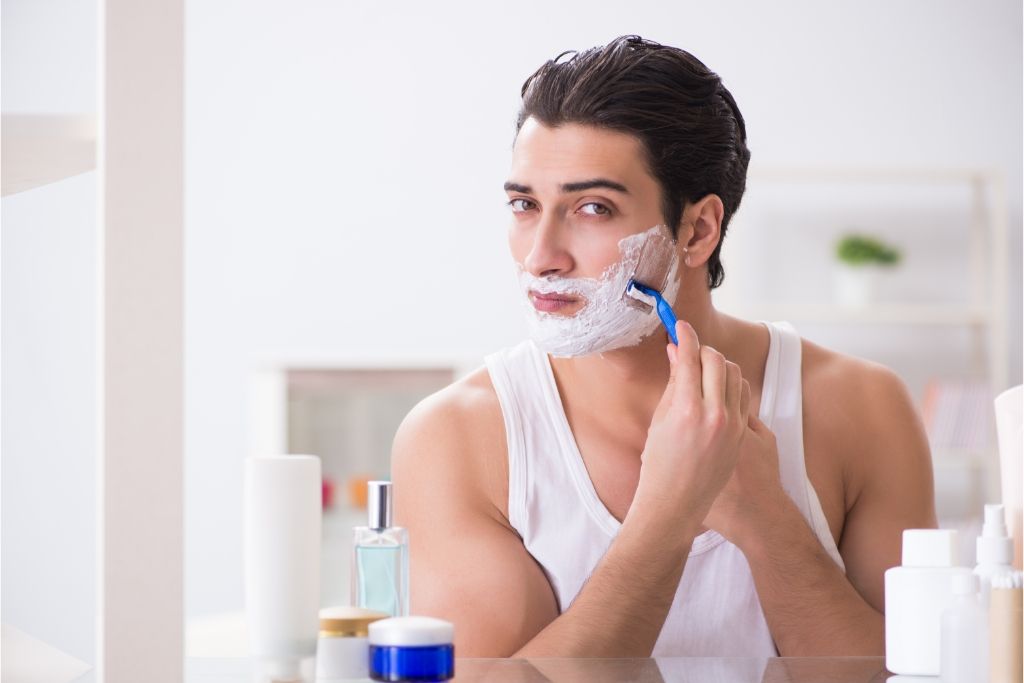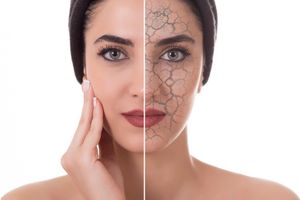Shaving can be a quick and easy task, but it can also lead to unsightly and painful ingrown hairs.
Ingrown hairs happen when the hair grows back into the skin instead of outwards, causing irritation, redness, and sometimes even infections.
Fortunately, by following these 10 shaving tips, you can prevent ingrown hairs from popping up and keep your skin looking smooth and healthy.
1)) Prep Your Skin Before Shaving
One of the best ways to prevent ingrown hairs is to make sure your skin is properly prepared for shaving.
Take a warm shower or bath before shaving to open up your pores and soften your hair follicles.
This will make it easier for your razor to glide over your skin and reduce the risk of irritation and ingrown hairs.
Tips To Help You Prep:
- Use a Facial Scrub: A good facial scrub can clear away dead skin cells that might otherwise clog your pores and lead to ingrown hairs. Look for a scrub designed for your skin type and use it gently to avoid causing irritation.
- Apply Pre-Shave Oil: Pre-shave oil not only softens your hair follicles but also creates a smooth surface for your razor to glide over. It can significantly reduce the risk of nicks, cuts, and importantly, ingrown hairs.
- Use a Hot Cloth or Towel: If you don't have time for a full shower or bath, soaking a cloth or towel in hot water and applying it to your face can achieve a similar effect. The heat helps open up your pores, making your hair easier to shave.
Preparing your skin before shaving is an essential step to prevent ingrown hairs.
Through effective practices such as gentle exfoliation, applying pre-shave oil, and using a hot cloth or towel, you can create a conducive environment for a smoother, pain-free shave.
The goal is to minimize irritation and ensure your razor glides effortlessly across your skin, reducing the chances of pesky ingrown hairs.
2)) Use A Sharp Razor
A dull razor blade can actually lead to more ingrown hairs. When a razor blade is dull, it can tug and pull on your hair, causing it to break off instead of getting cut cleanly.
This leads to shorter hairs that can more easily curl back into the skin.
Make sure you use a sharp razor blade every time you shave to prevent this from happening.
Pro-Tip: When selecting a razor, opt for quality over quantity. It might be tempting to go for a cheap, multi-pack disposable option, but investing in a high-quality razor can significantly reduce the risk of ingrown hairs. Choose a razor with multiple blades and a pivoting head that can adapt to the contours of your face, ensuring a closer and smoother shave. Also, consider a razor with a moisturizing strip for added skin protection. Replace your razor or the blade regularly to keep it sharp and efficient.
Utilizing a sharp razor is crucial in your shaving routine to prevent the occurrence of ingrown hairs.
A quality, sharp blade ensures a clean and smooth shave, reducing the likelihood of hair breakage and subsequent ingrown hairs.
Regularly replacing your razor or blade further enhances shaving efficiency.
In essence, investing in a good razor and maintaining its sharpness can significantly contribute to a healthier, smoother, and more comfortable shaving experience.
3)) Don't Shave Too Close
While you may be tempted to get a super close shave, it's actually better to leave a little bit of stubble.
When you shave too close, you create a very sharp edge on the hair that is more likely to grow back into the skin.
Leave a small amount of stubble to help prevent this from happening.
Tips To Help Prevent Shaving Too Close:
- Adjust Your Razor: Most razors have adjustable settings to control how close the shave is. If you're prone to ingrown hairs, consider setting your razor to a higher setting to leave a bit of stubble.
- Use Light Strokes: Applying too much pressure while shaving can result in a too-close shave. Instead, use light, gentle strokes and let the razor do the work.
- After-Shave Care: Applying a soothing after-shave lotion can help reduce skin irritation. Look for products with ingredients like aloe vera or chamomile, which are known for their soothing properties.
Pro-Tip: Electric shavers can be an effective tool in preventing overly close shaves that lead to ingrown hairs. Many electric shavers are designed with a protective foil between the blades and your skin, ensuring you don't shave too close. They also allow for easy control over the shave's closeness, further reducing the risk of hairs curling back into the skin. Opt for an electric shaver with adjustable settings, and remember, a slightly less close shave can mean significant relief from the discomfort of ingrown hairs.
Avoiding an overly close shave is another effective strategy to prevent ingrown hairs.
By adjusting your razor's settings, employing light, gentle strokes, and incorporating a soothing after-shave care routine, you can maintain a slight stubble and reduce the risk of hairs growing back into the skin.
Ultimately, it involves achieving a balance between obtaining a clean shave and maintaining skin health, ensuring your shaving practices do not lead to uncomfortable and unsightly ingrown hairs.
4)) Use Shaving Cream Or Gel
Shaving cream or gel acts as a lubricant, helping your razor blade glide over your skin without causing irritation or bumps.
Be sure to apply a generous amount of shaving cream or gel before you begin shaving.
Pro-Tip: When selecting your shaving cream or gel, aim for a product that is rich in natural moisturizers and free from harsh chemicals. Ingredients like aloe vera, shea butter, and essential oils can nourish and protect the skin, promoting a smoother shave. Avoid products with alcohol as this can dry out your skin and increase the risk of irritation and ingrown hairs. A quality shaving cream or gel should create a thick lather that allows the razor to glide effortlessly across your skin without tugging or pulling.
Incorporating a quality shaving cream or gel into your grooming routine is a game-changer in preventing the occurrence of ingrown hairs.
Such products provide the necessary lubrication for your razor to glide smoothly, minimizing skin irritation and the likelihood of hairs curling back into the skin.
Opting for a cream or gel rich in natural moisturizers and devoid of harsh chemicals can further enhance your shaving experience, offering you not just a smoother shave, but healthier, happier skin.
5)) Shave In The Direction Of Hair Growth
Shaving in the opposite direction of hair growth can lead to ingrown hairs, so it's important to shave in the same direction that your hair is growing.
This may require more passes with your razor blade, but it's worth it to prevent ingrown hairs.
Tips To Help You Get The Direction Correct:
- Identify Your Hair Growth Pattern: Before you shave, take a moment to observe the direction your hair is growing. This is often referred to as the 'grain'. If you're unsure, let your hair grow out slightly - it will be easier to see the pattern.
- Use Short Strokes: When shaving in the direction of hair growth, using short strokes can give you more control and help prevent you from accidentally going against the grain.
- Double Check: After each stroke, check to ensure you are indeed shaving in the direction of the hair growth. This is particularly important in areas where the hair growth pattern might change direction.
Shaving in the direction of hair growth is essential to help avoid the discomfort of ingrown hairs.
By identifying your hair's growth pattern, using short, controlled strokes, and checking your technique after each pass, you can ensure you're following this crucial shaving rule.
It might require more effort and time, but the benefits it offers in terms of reducing the risk of ingrown hairs make it a worthwhile practice.
When it comes to shaving, it's not about speed but carefulness and attention to detail.
6)) Exfoliate Regularly
Exfoliating helps remove dead skin cells that can clog your pores and lead to ingrown hairs.
Use a gentle exfoliating scrub or brush to help keep your skin smooth and free from ingrown hairs.
Tips For Making Exfoliating A Breeze:
- Choose the Right Exfoliator: Not all exfoliators are created equal. For your face, opt for a gentle, chemical exfoliator with ingredients like salicylic or lactic acid. For your body, a scrub with larger, natural particles like salt or sugar can provide effective exfoliation.
- Don't Overdo It: While exfoliation is beneficial, too much can irritate your skin and even lead to more ingrown hairs. As a rule of thumb, aim to exfoliate 1-2 times per week.
- Post-Exfoliation Care: After you exfoliate, your skin can be a bit sensitive. It's important to hydrate and soothe the skin with a moisturizer or lotion, ideally one that is fragrance-free and packed with skin-soothing ingredients like aloe vera or chamomile.
Regular exfoliation is a key preventive measure against ingrown hairs, aiding in the removal of dead skin cells that could potentially block pores.
The selection of an appropriate exfoliator, moderation in its usage, and careful post-exfoliation care can optimize the benefits of this process.
Effective exfoliation is not about harshness but gentleness, ensuring your skin remains smooth and ingrown hair-free.
7)) Moisturize After Shaving
After shaving, your skin can become dry and irritated. Make sure you moisturize your skin to keep it healthy and hydrated.
This will also help prevent ingrown hairs by keeping your skin soft and supple.
Tips To Help You Moisturize:
- Choose a Moisturizer Suited to Your Skin Type: If you have oily skin, opt for a light, oil-free moisturizer. For dry or sensitive skin, a thicker, hydrating cream or lotion might be more beneficial. Look for ingredients such as hyaluronic acid, glycerin, or ceramides that are known for their hydrating properties.
- Apply While Skin is Still Damp: For maximum absorption, apply your moisturizer immediately after patting your skin dry post-shaving. This helps to seal in moisture and keep your skin hydrated for longer.
- Don't Forget Your Neck: The skin on your neck is just as susceptible to dryness and irritation from shaving. Ensure you extend the application of your moisturizer to your neck area as well.
Moisturizing after shaving is a vital step in maintaining skin health and preventing ingrown hairs.
Selecting a moisturizer that suits your skin type, applying it while your skin is still damp from shaving, and remembering to extend the care to your neck are all factors that contribute to effective post-shave hydration.
Regular moisturizing ensures your skin remains soft, lessening the chance of hair curling back into your skin, and ultimately, reducing the likelihood of ingrown hairs.
8)) Avoid Tight Clothing
Wearing tight clothing can rub against your skin and irritate hair follicles, leading to ingrown hairs.
Choose loose-fitting clothing, especially around the areas where you shave.
Ideas To Help You Avoid Irritation Caused By Clothing:
- Opt for Breathable Fabrics: To minimize friction and irritation, choose fabrics that are breathable, like cotton or bamboo, particularly for clothing next to your shaved areas. These materials can help to reduce sweat and irritation that might lead to ingrown hairs.
- Prioritize Comfort: Comfort should always be a top priority. If clothing feels too tight, especially around shaved areas, it's a good idea to size up to reduce the risk of ingrown hairs.
- Loose Clothing Post-Shave: After shaving, try to wear loose clothing for a few hours. This can give your skin a chance to breathe and recover, reducing the chances of irritation and ingrown hairs.
Avoiding tight clothing, particularly around shaved areas, is a simple and effective way to prevent ingrown hairs.
By choosing breathable fabrics, prioritizing comfort, and opting for loose clothing after shaving, you can successfully minimize the skin irritation and friction that often lead to the development of ingrown hairs.
Your clothing choices play a significant role in maintaining the health and comfort of your skin post-shave.
9)) Don't Shave Too Often
Shaving too frequently can lead to irritation and ingrown hairs. Give your skin a rest every now and then by skipping a day or two of shaving.
This will also give your hair a chance to grow out a little bit, which can help prevent ingrown hairs.
Tips To Help You Create A Shaving Schedule:
- Develop a Shaving Schedule: Instead of shaving daily, try to establish a routine where you shave every other day or every three days. This gives your skin ample time to recover, reducing the likelihood of irritation and ingrown hairs.
- Invest in a Quality Razor: A quality razor can provide a closer shave, meaning you won't have to shave as often. Opt for one with multiple blades and a flexible head to follow the contours of your body and reduce the risk of nicking the skin.
- Consider Alternative Hair Removal Methods: If you find your skin is frequently irritated by shaving, consider exploring other hair removal methods. Waxing, for example, removes hair at the root, allowing for a longer time between treatments. Laser hair removal, though more costly upfront, can lead to permanent hair reduction over time.
Restraining from frequent shaving is a proactive measure in reducing the occurrence of ingrown hairs.
Establishing a sensible shaving schedule, investing in a high-quality razor, and considering alternative methods of hair removal are all effective strategies for achieving this goal.
Your skin needs time to recuperate between shaves, and providing this time can significantly reduce irritation and the subsequent development of ingrown hairs.
Shaving less often, thus, may lead to healthier skin and a more comfortable shave when you do.
10)) Consider Other Hair Removal Methods
If you're prone to ingrown hairs, you may want to consider other hair removal methods, such as waxing or using depilatory creams.
These methods can remove hair from the root, which can reduce the risk of ingrown hairs.
Ideas For Choosing An Alternative Hair Removal Method:
- Research Your Options: Before jumping into a new hair removal method, do your research. Each method has its pros and cons, and understanding these can help you make an informed decision. Some methods may be more suitable for certain skin or hair types, so it's critical to find out what works best for you.
- Try Waxing or Sugaring: Both waxing and sugaring remove hair from the root, which can help to reduce the occurrence of ingrown hairs. These methods may cause temporary discomfort but usually result in smoother skin for longer periods as compared to shaving.
- Consider Professional Treatments: For a more permanent solution, consider professional treatments such as laser hair removal or electrolysis. While these methods may require a larger upfront cost, they can significantly reduce hair growth over time and hence, the risk of ingrown hairs. Always seek these treatments from licensed professionals to ensure safe and effective results.
Exploring other hair removal methods can be particularly beneficial if you're prone to ingrown hairs.
By doing your due diligence, you can uncover a method that best suits your skin and hair type, potentially reducing the risk of skin irritation and ingrown hairs.
Whether you choose to wax, sugaring, or opt for professional treatments like laser hair removal or electrolysis, it's essential to remember that the main goal is to maintain the health and comfort of your skin.
So, consider alternative hair removal methods to find the one that brings the best results for you.
Conclusion
Preventing ingrown hairs is a multifaceted endeavor, requiring a combination of careful shaving techniques, wise clothing choices, and considering alternative hair removal methods.
This guide has offered a range of practical suggestions to help you minimize the risk and discomfort associated with ingrown hairs.
Every person's skin is different, and the effectiveness of these tips can vary from individual to individual.
The ultimate goal is to find a hair removal routine that best suits your unique skin type and lifestyle, promoting skin health and comfort.
Adherence to these guidelines can help pave the way for a smoother, more enjoyable shaving experience.
Related Articles and Guides
- How To Get Rid Of Ingrown Hairs On Face
- How To Get Rid Of Ingrown Hairs On Legs
- How To Get Rid Of Hair Bumps On Neck
- 10 FAQs About How To Get Rid Of Ingrown Hairs
- 10 Must-Know Ingrown Hair Hacks For Clear Skin
Download Our Free E-book!







